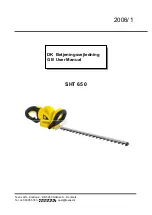
EN
Translation
of
the
original
instructions
17
b)
Do not use the machine in explosive atmosphere where flammable liquids, gases or dust are
present.
Power tools create sparks which may ignite such dust or vapours.
c)
Keep children and bystanders at a safe distance
while operating a power tool.
Distractions can result
in losing control over the machine.
2) Electrical Safety
a)
The power tool plugs must match the given outlet. Never modify the plug in any way whatsoever. Do
not use any adaptor plugs with grounded power tools.
Using unmodified plugs and suitable outlets
reduce the risk of electric shocks.
b)
Avoid body contact with grounded surfaces such as pipes, heat radiators, stoves and refrigerators.
There is an increased risk of electric shock if your body is grounded.
c)
Do not expose power tools to rain.
Water entering the power tool increases the risk of electric shock.
d)
Do not use the cable for any other than the intended purposes. Never use the cord for carrying or
suspending the power tool. Do not pull the plug from the outlet by pulling the cord. Keep the cord
away from high temperatures, oil, sharp edges and moving parts of the machine.
Damaged or
entangled cords increase the risk of electric shock.
e)
When operating power tools outdoors, use only such extension cords that have been approved for
outdoor use.
Using extension cords that are suitable for outdoor use reduces the risk of electric shock.
f)
If operating a power tool in a damp environment is unavoidable, use a residual current device
(RCD).
Using an RCD reduces the risk of electric shock.
3) Personal Safety
a)
Stay alert, watch what you are doing and use common senses when operating power tools. Do not
use power tools if you are tired or under the influence of drugs, alcohol or medication.
Losing
concentration while operating power tools for even a short moment may result in a serious injury.
b)
Use personal protective equipment and always wear eye protection.
Using protective equipment, such
as dust masks, non-skid work boots, hard hat or hearing protection, depending on the type and usage
manner of the given power tool, reduces the risk of injuries.
c)
Prevent unintentional starting of the machine. Ensure the switch is in the OFF position before
connecting the plug to the outlet.
Carrying power tools with your finger on the switch or plugging them
into an outlet while being turned on may result in an injury.
d)
Remove any adjustment tools and/or keys before turning the machine on.
A tool and/or key left at the
rotating part of the machine may result in an injury.
e)
Do not overreach. Stay in a stable position and always balanced.
This will give you a better control over
the machine in unexpected situations.
f)
Dress properly. Do not wear loose clothing or jewellery. Keep your hair, clothing and footwear away
from moving parts.
Loose clothing, jewellery or long hair can get caught in the machine’s moving parts.
g)
If the used power tools can be connected to dust extraction and catchment devices, make sure
these are connected and used properly.
Using these devices reduces dust-related hazards.
4) Power Tools, Use and Care
a)
Do not overload the power tool. Use the power tool that is appropriate for your work.
Using a correct
power tool makes the work within the specified power output range easier and safer.
b)
Do not use power tools with damaged switches.
Power tools that cannot be turned on or off are
dangerous and must be repaired.
c)
Disconnect the plug from the outlet prior to making any machine adjustments, replacing
accessories or storing the machine.
This will prevent unintentional starting of the machine.
d)
Store unused power tools away from children. Do not let persons unfamiliar with the power tool or
these instructions to operate the power tools.
Power tools are dangerous in the hands of inappropriately
trained people.
e)
Take care of your power tools thoroughly. Make sure that the moving parts of the machine work
flawlessly and do not jam and that individual parts are not broken or damaged to such an extent that












































